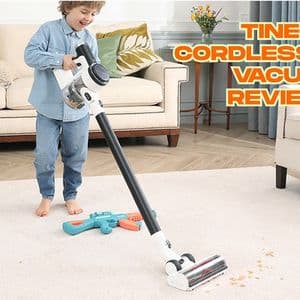What Determines Cordless Vacuum Battery Life?
You might be wondering:
Why do some batteries last longer than others?
Several factors influence battery longevity in cordless vacuums:
-
Battery Type: Most modern cordless vacuums use lithium-ion batteries, which are lighter and hold a charge longer than older nickel-cadmium batteries.
-
Motor Power: Higher suction levels consume more energy, draining the battery faster.
-
Usage Patterns: Frequent use at max power reduces lifespan faster than moderate use.
-
Charging Habits: Overcharging or leaving your vacuum plugged in constantly may reduce the battery’s overall lifespan.
-
Environmental Factors: Using or storing vacuums in hot environments can degrade the battery.
By understanding these variables, you can begin to manage your expectations and use your vacuum in a way that supports longer battery health.
Average Cordless Vacuum Battery Life
On average, a cordless vacuum may offer 15 to 60 minutes per charge depending on suction mode and battery capacity.
In eco mode, you may enjoy longer runtime, but in max power mode for deep cleaning, battery life shortens significantly. Over the long term, most lithium-ion batteries can handle 300 to 500 charge cycles before noticeable decline.
Signs Your Cordless Vacuum Battery Is Declining
Here’s what to look for:
-
Shorter runtime even after a full charge.
-
The vacuum shutting off unexpectedly during use.
-
Longer charging times than usual.
-
Reduced suction power, which sometimes indicates insufficient battery output.
These signs signal it may be time to replace the battery or adjust your usage habits to preserve battery efficiency.
Practical Tips to Extend Cordless Vacuum Battery Life
Let’s dive into what you can do to keep your cordless vacuum battery performing well.
Charge Correctly
Avoid leaving your vacuum on the charger longer than necessary. If your vacuum comes with smart charging, it will stop drawing power once fully charged. Otherwise, it’s wise to unplug after a full charge.
Store in a Cool, Dry Place
Heat is a battery’s enemy. Store your vacuum away from direct sunlight or hot garages to prevent battery degradation.
Use Appropriate Power Modes
You may not need max suction for every cleaning session. Use eco or standard modes for general cleaning and reserve max mode for deep-cleaning areas like carpets.
Clean Filters and Brush Roll
Clogged filters and brush rolls force the motor to work harder, draining the battery faster. Cleaning these parts regularly will improve airflow and reduce battery strain.
Use Regularly
Batteries perform best when used regularly. If you leave your vacuum unused for extended periods, the battery can self-discharge, affecting longevity.
Why Battery Care Matters
If you’re considering a cordless vacuum with wall mount charger, proper battery care becomes even more crucial since many of these systems encourage frequent top-off charging. The convenience of grab-and-go cleaning is only as good as the battery’s condition.
By taking care of your vacuum’s battery, you maximize runtime, reduce replacement costs, and enjoy a consistent cleaning experience over time.
Factors to Consider When Evaluating Cordless Vacuum Battery Life
When researching cordless vacuums, you may notice battery specifications listed in volts (V) or ampere-hours (Ah). Here’s what they mean:
-
Voltage (V): Relates to power output. Higher voltage can support stronger suction.
-
Ampere-hour (Ah): Relates to battery capacity. Higher Ah typically means longer runtime.
However, a vacuum with a higher voltage may consume more energy, reducing the battery’s runtime despite having a powerful motor. Balance suction power with your cleaning needs to ensure the battery life aligns with your routine.
The Role of Weight and Design
Some consumers look for the best rated lightweight vacuum when selecting a cordless vacuum, valuing ease of maneuverability alongside battery life. A lightweight design can often correlate with a smaller battery capacity, so understanding this trade-off helps in setting realistic expectations for runtime.
If you need to clean large areas, a slightly heavier vacuum with a higher-capacity battery may be a better choice. If you prioritize quick, lightweight spot cleaning, a shorter battery runtime may be sufficient for your needs.
Bucket Brigade: So, How Can You Tell If a Cordless Vacuum Has Good Battery Life?
Ask yourself:
-
Does it offer a runtime that covers your typical cleaning session?
-
Does it have a replaceable battery for extended lifetime use?
-
Can you adjust suction modes to balance power and runtime?
-
Does the vacuum have clear battery indicators to prevent surprises?
If you can answer “yes” to these, you’re likely to have a cordless vacuum that supports your cleaning needs efficiently.
Is It Worth Replacing a Cordless Vacuum Battery?
Replacing a vacuum’s battery may cost less than buying a new vacuum. However, consider the following:
-
The vacuum’s overall condition (motor and filters).
-
Availability and cost of a replacement battery.
-
The vacuum’s age relative to new technology improvements.
If the vacuum is in good condition and the replacement battery is reasonably priced, replacement can extend your vacuum’s useful life while keeping your cleaning routine consistent.
Read more: Lightweight Vacuum Cleaners Reviews
Future Trends in Cordless Vacuum Battery Life
Advancements in battery technology are consistently improving cordless vacuum battery life. Newer models incorporate:
-
Faster charging times.
-
Improved energy efficiency.
-
Better battery management systems.
-
Removable batteries for extended runtime through hot-swapping.
These trends suggest cordless vacuums will continue to improve, making them more practical for everyday use in larger homes.
Final Thoughts
Cordless vacuum battery life significantly influences your cleaning efficiency, convenience, and long-term satisfaction with your vacuum. By understanding what affects battery performance and adopting good battery care habits, you can maximize runtime and reduce unexpected interruptions.
Choosing a vacuum that aligns with your cleaning needs—whether prioritizing lightweight designs, wall-mounted charging, or extended battery runtime—will ensure your cordless vacuum continues to serve your household effectively.










